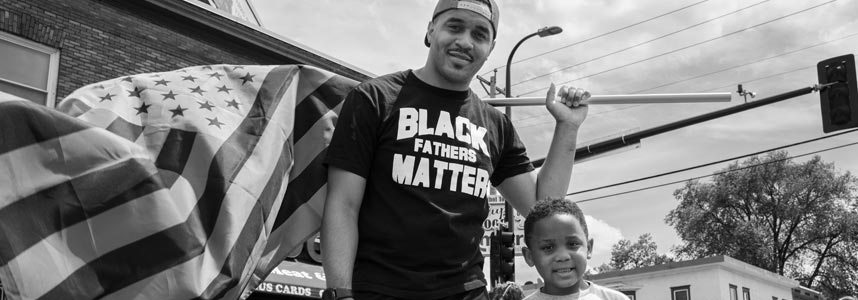Faced with an unexpected opening this spring, College of Saint Benedict and Saint John’s University Gallery Manager Becky Pflueger saw an opportunity to spark some needed conversation.
Typically, the annual Senior Thesis Show would fill up both the Benedict and Dorothy Gorecki Gallery in CSB’s Benedicta Arts Center and the Alice R. Rogers and Target Galleries at SJU.
But with only 12 graduating seniors this year, that show could be contained to SJU this time around.
That gave Pflueger the chance to book a visually-powerful show she saw on display at the Minnesota African American Heritage Museum and Gallery in Minneapolis.
For George: Portraits of the Movement is a collection of black-and-white portraits taken by Minneapolis photographer John Steitz, as well as interviews he conducted with those he photographed.
In May of 2020, Steitz was living in the Powderhorn neighborhood, just blocks from the intersection of 38th Street and Chicago Avenue where George Floyd was killed in police custody after Minneapolis police officer Derek Chauvin – who has been convicted of murder and manslaughter for his role in the incident – pressed his knee on Floyd’s neck for more than nine minutes.
Floyd’s death sparked nationwide condemnation and protests – especially in Minneapolis which saw not only protests, but civil unrest. Steitz, though, continued to visit the intersection – now known as George Floyd Square – in the months afterward, taking the time to listen to those who gathered there to both mourn and demonstrate.

The result is an exhibit that spotlights the individual stories of those who were moved enough to get involved in trying to build community and demand change.
“It really opens up the conversation about what the protests actually looked like and who the people were who were going to them,” Pflueger said. “It puts a human face to those individuals and their choices. Why were they there? It wasn’t just about violence. It was about building a community and making a difference.”
In the months after Floyd’s death, the executive boards of the CSB and SJU Student Senates formulated a call to action – one Pflueger said she has been trying to heed in her booking choices.
“We have already started working on an indigenous artist show over at Saint John’s next fall,” she said. “That will start in August. Part of the reason behind that show is that one of the big things the Senate called for was having conversations about diversity outside of classroom spaces.
“I tried to think about that when booking this show as well. We’ve had a lot of really visually beautiful art in the galleries this season, but I wanted to do something that would spark more of a conversation.”
The exhibit now on display at CSB through May 9 features 50 of Steitz’s images, which were drawn from a collection of around 120 to 150 in all. The portraits sit side-by-side with quotes from and information about the individuals pictured.
Steitz said he saw himself more as a journalist than an artist when putting the collection together.
“For me, it really started as a general impulse,” he said. “I’ve never organized any of my work into a cohesive project like this. It sprang out of a general disappointment with the way I thought the media was covering what was happening in my neighborhood.
“The national media has the tendency to zoom out, and when they do that they miss the human elements. But that was one of the most incredible things I witnessed – all these individuals with their own amazing stories who got involved.
“I guess what I hope is that people hear the words these folks had to say. I don’t want it to be interpreted through my own perspective or anything like that. It takes a whole lot of people to create a movement – people with different motivations and different backgrounds. I want people to see them and hear their stories.”
